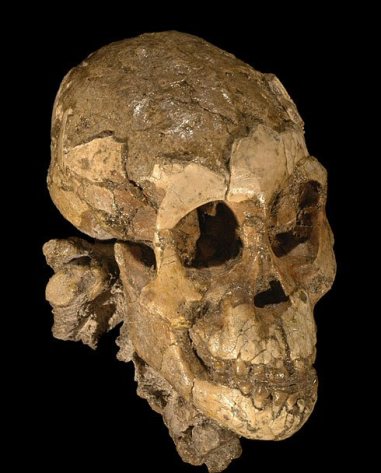
September 21, 2006
Click on image for full size version
According to a new study published on September 21st in Nature, what is being called "Lucy’s child" or "Selam," may change how human-like we consider some Australopithecus species. Has the picture of "Lucy" – Australopithecus afarensis – been too humanlike? Could some unknown hairy hominoid reports from Africa be relicts of australopithecines, after all?
Tracy Press writing for the Associated Press, notes, in part:
The 3.3-million-year-old fossil of a 3-year-old child could shed new light on the evolution of modern humans’ earliest ancestors.
NEW YORK — In a discovery sure to fuel an old debate about our evolutionary history, scientists have found a remarkably complete skeleton of a 3-year-old female from the ape-man species represented by “Lucy.”
The remains found in Africa are 3.3 million years old, making this the oldest known skeleton of such a youthful human ancestor.
“It’s a pretty unbelievable discovery… It’s sensational,” said Will Harcourt-Smith, a researcher at the American Museum of Natural History in New York who wasn’t involved in the find. “It provides you with a wealth of information.”
For one thing, it gives new evidence for a contentious feud about whether this species, which walked upright, also climbed and moved through trees easily.
The species is Australopithecus afarensis, which lived in Africa between about 4 million and 3 million years ago. The most famous afarensis is Lucy, discovered in Ethiopia in 1974, a creature that lived about 100,000 years after the newfound specimen.
The new find is reported in Thursday’s issue of the journal Nature by Zeresenay Alemseged of the Max Planck Institute for Evolutionary Anthropology in Leipzig, Germany; Fred Spoor, professor of evolutionary anatomy at University College London, and others.
The skeleton was discovered in 2000 in northeastern Ethiopia. Scientists have spent five painstaking years removing the bones from sandstone, and the job will take years more to complete.
Judging by how well it was preserved, the skeleton may have come from a body that was quickly buried by sediment in a flood, the researchers said.
“It’s a once-in-a-lifetime find,” said Spoor.
The skeleton has been nicknamed “Selam,” which means “peace” in several Ethiopian languages.
Most scientists believe afarensis stood upright and walked on two feet, but they argue about whether it had ape-like agility in trees.
That climbing ability would require anatomical equipment like long arms, and afarensis had arms that dangled down to just above the knees. The question is whether such features indicate climbing ability or just evolutionary baggage. The loss of that ability would suggest crossing a threshold toward a more human existence.
Spoor said so far, analysis of the new fossil hasn’t settled the argument but does seem to indicate some climbing ability.
While the lower body is very human-like, he said, the upper body is ape-like:
—The shoulder blades resemble those of a gorilla rather than a modern human.
—The neck seems short and thick like a great ape’s, rather than the more slender version humans have to keep the head stable while running.
—The organ of balance in the inner ear is more ape-like than human.
—The fingers are very curved, which could indicate climbing ability, “but I’m cautious about that,” Spoor said. Curved fingers have been noted for afarensis before, but their significance is in dispute.
A big question is what the foot bones will show when their sandstone casing is removed, he said. Will there be a grasping big toe like the opposable thumb of a human hand Such a chimp-like feature would argue for climbing ability, he said.
Yet, to resolve the debate, scientists may have to find a way to inspect vanishingly small details of such old bones, to get clues to how those bones were used in life, he said.
Bernard Wood of George Washington University, who didn’t participate in the discovery, said in an interview that the fossil provides strong evidence of climbing ability. But he also agreed that it won’t settle the debate among scientists, which he said “makes the Middle East look like a picnic.”
Overall, he wrote in a Nature commentary, the discovery provides “a veritable mine of information about a crucial stage in human evolutionary history.”
About Loren Coleman
Loren Coleman is one of the world’s leading cryptozoologists, some say “the” leading living cryptozoologist. Certainly, he is acknowledged as the current living American researcher and writer who has most popularized cryptozoology in the late 20th and early 21st centuries.
Starting his fieldwork and investigations in 1960, after traveling and trekking extensively in pursuit of cryptozoological mysteries, Coleman began writing to share his experiences in 1969. An honorary member of Ivan T. Sanderson’s Society for the Investigation of the Unexplained in the 1970s, Coleman has been bestowed with similar honorary memberships of the North Idaho College Cryptozoology Club in 1983, and in subsequent years, that of the British Columbia Scientific Cryptozoology Club, CryptoSafari International, and other international organizations. He was also a Life Member and Benefactor of the International Society of Cryptozoology (now-defunct).
Loren Coleman’s daily blog, as a member of the Cryptomundo Team, served as an ongoing avenue of communication for the ever-growing body of cryptozoo news from 2005 through 2013. He returned as an infrequent contributor beginning Halloween week of 2015.
Coleman is the founder in 2003, and current director of the International Cryptozoology Museum in Portland, Maine.
Filed under CryptoZoo News, Cryptozoology, Extinct